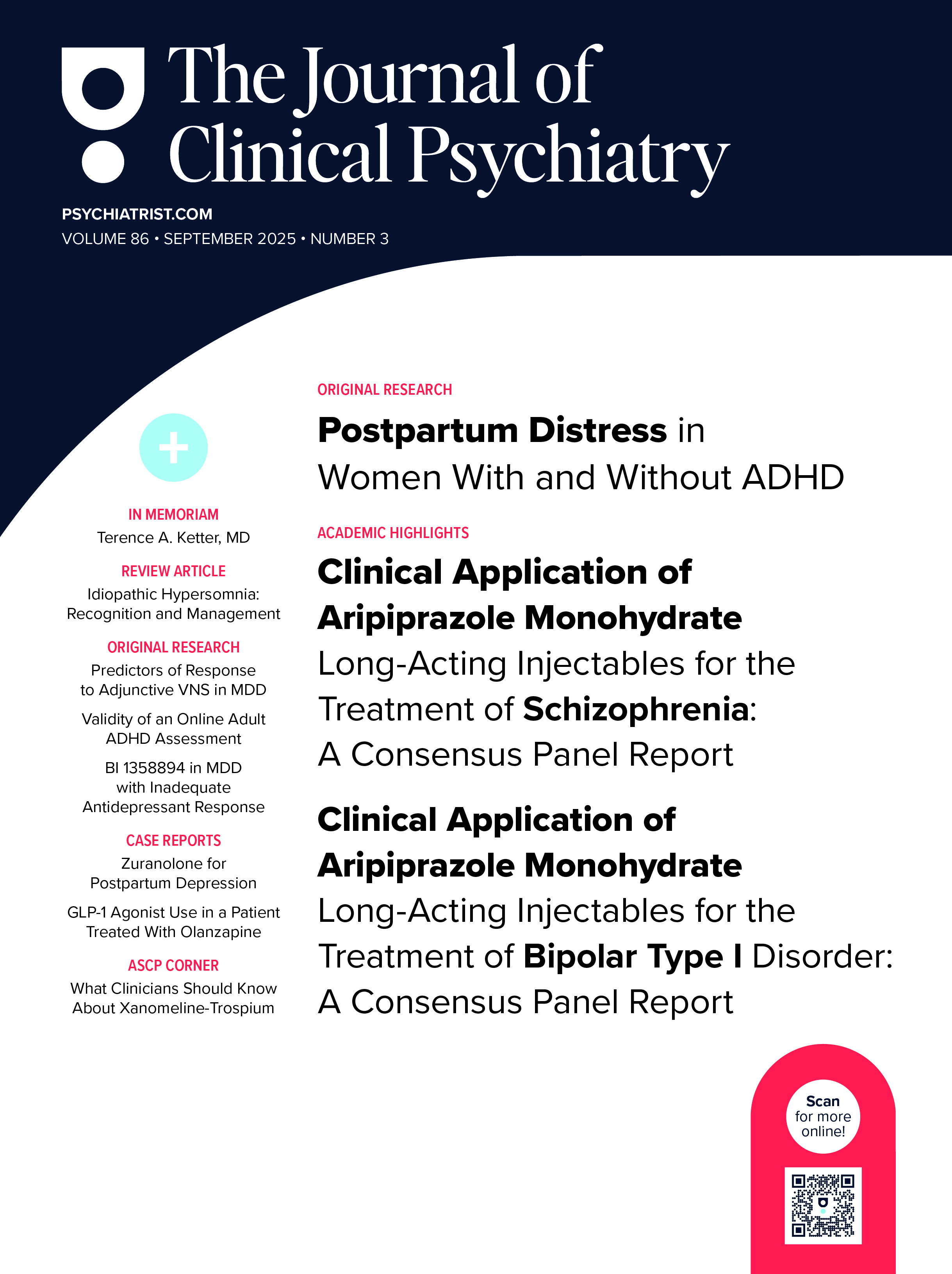Abstract
Objective: The prevalence of depressive and anxiety disorders is higher in women than in men. In contrast, there is still no clear consensus on the existence of sex-related differences in the effectiveness of antidepressant treatments for these disorders. This real-world study used filled prescription sequences to compare antidepressant medications between women and men at a medication level according to their acceptability (ie, combination of efficacy and tolerability).
Methods: In a nationwide cohort from the French national health data system (Système National des Données de Santé [SNDS]), 1.2 million people were identified as new antidepressant users for any condition in 2011. The outcome was clinical acceptability as measured by the continuation/change ratio over the 6- month period following the introduction of the first-line treatment. Continuation was defined as at least 2 refills of the same treatment. Change was defined as at least one filled prescription of another antidepressant, an antipsychotic medication, or a mood stabilizer. Adjusted odds ratios (aORs) were computed through multivariable binary logistic regressions.
Results: Overall, after the first prescription of an antidepressant, the continuation/ change ratio was slightly higher for women than men (aOR [95% CI], 1.06 [1.05–1.08]), with escitalopram ranking first in both. Sex-by-medication interactions were significant for paroxetine (0.91 [0.88–0.95]) and fluoxetine (1.19 [1.12–1.26]) only. Specifically, fluoxetine was significantly more acceptable in female than in male participants (0.73 [0.70–0.75] vs 0.63 [0.60–0.67]), whereas paroxetine was more acceptable in male than in female participants (0.75 [0.72–0.78] vs 0.68 [0.66–0.70]).
Conclusion: These real-world data may help practitioners and policymakers prioritize choice of antidepressant medications in women and men.
J Clin Psychiatry 2024;85(4):23m15128
Author affiliations are listed at the end of this article.
Members Only Content
This full article is available exclusively to Professional tier members. Subscribe now to unlock the HTML version and gain unlimited access to our entire library plus all PDFs. If you’re already a subscriber, please log in below to continue reading.
References (59)

- Cuijpers P, Vogelzangs N, Twisk J, et al. Comprehensive meta-analysis of excess mortality in depression in the general community versus patients with specific illnesses. Am J Psychiatry. 2014;171:453–462. PubMed CrossRef
- GBD 2019 Mental Disorders Collaborators. Global, regional, and national burden of 12 mental disorders in 204 countries and territories, 1990-2019: a systematic analysis for the Global Burden of Disease Study 2019. Lancet Psychiatry. 2022;9(2):137–150. PubMed CrossRef
- Penninx BW, Pine DS, Holmes EA, et al. Anxiety disorders. Lancet. 2021;397:914–927. PubMed CrossRef
- Blanco C, Wall MM, Hoertel N, et al. Psychiatric disorders and risk for multiple adverse outcomes: a national prospective study. Mol Psychiatry. 2021;26(3):907–916. PubMed CrossRef
- Hoertel N, Franco S, Wall MM, et al. Mental disorders and risk of suicide attempt: a national prospective study. Mol Psychiatry. 2015;20(6):718–726. PubMed CrossRef
- National Institute for Health and Care Excellence. Depression in adults: treatment and management (NICE guideline NG222). National Institute for Health and Care Excellence. 2022. https://www.nice.org.uk/guidance/ng222/resources/depression-in-adults-treatment-and-management-pdf-66143832307909.
- Agence Nationale de Sécurité du Médicament et des Produits de Santé. Traitement par antidépresseurs. ANSM. 2019. https://archive.ansm.sante.fr/Dossiers/Traitementspar-antidepresseurs/Traitement-par-antidepresseurs/(offset)/0.
- Slee A, Nazareth I, Bondaronek P, et al. Pharmacological treatments for generalised anxiety disorder: a systematic review and network meta-analysis. Lancet. 2019;393:768–777. PubMed CrossRef
- Iacobucci G. NHS prescribed record number of antidepressants last year. BMJ. 2019;364:l1508. PubMed CrossRef
- Bogowicz P, Curtis HJ, Walker AJ, et al. Trends and variation in antidepressant prescribing in English primary care: a retrospective longitudinal study. BJGP Open. 2021;5(4):BJGPO.2021.0020. PubMed CrossRef
- Malhi GS, Mann JJ. Depression. Lancet. 2018;392(10161):2299–2312. PubMed CrossRef
- Dold M, Kasper S. Evidence-based pharmacotherapy of treatment-resistant unipolar depression. Int J Psychiatry Clin Pract. 2017;21(1):13–23. PubMed
- MacQueen G, Santaguida P, Keshavarz H, et al. Systematic review of clinical practice guidelines for failed antidepressant treatment response in major depressive disorder, dysthymia, and subthreshold depression in adults. Can J Psychiatry. 2017;62(1):11–23. PubMed
- Malhi GS, Bell E, Singh AB, et al. The 2020 Royal Australian and New Zealand College of Psychiatrists clinical practice guidelines for mood disorders: major depression summary. Bipolar Disord. 2020;22(8):788–804. PubMed CrossRef
- Boyce P, Hopwood M, Morris G, et al. Switching antidepressants in the treatment of major depression: when, how and what to switch to? J Affect Disord. 2020;261:160–163. PubMed
- Gabriel FC, de Melo DO, Fráguas R, et al. Pharmacological treatment of depression: a systematic review comparing clinical practice guideline recommendations. PLoS One. 2020;15(4):e0231700. PubMed CrossRef
- Trivedi MH, Rush AJ, Wisniewski SR, et al. Evaluation of outcomes with citalopram for depression using measurement-based care in STAR*D: implications for clinical practice. Am J Psychiatry. 2006;163(1):28–40. PubMed
- Platt JM, Bates L, Jager J, et al. Is the US gender gap in depression changing over time? A meta-regression. Am J Epidemiol. 2021;190(7):1190–1206. PubMed
- Kessler RC. Epidemiology of women and depression. J Affect Disord. 2003;74(1):5–13. PubMed
- Marcus SM, Young EA, Kerber KB, et al. Gender differences in depression: findings from the STAR*D study. J Affect Disord. 2005;87(2–3):141–150. PubMed CrossRef
- Young MA, Scheftner WA, Fawcett J, et al. Gender differences in the clinical features of unipolar major depressive disorder. J Nerv Ment Dis. 1990;178(3):200–203. PubMed CrossRef
- Sutin AR, Zonderman AB. Depressive symptoms are associated with weight gain among women. Psychol Med. 2012;42(11):2351–2360. PubMed CrossRef
- Anderson JC, Williams S, McGee R, et al. DSM-III disorders in preadolescent children. Prevalence in a large sample from the general population. Arch Gen Psychiatry. 1987;44(1):69–76. PubMed CrossRef
- Sramek JJ, Murphy MF, Cutler NR. Sex differences in the psychopharmacological treatment of depression. Dialogues Clin Neurosci. 2016;18(4):447–457. PubMed CrossRef
- LeGates TA, Kvarta MD, Thompson SM. Sex differences in antidepressant efficacy. Neuropsychopharmacology. 2019;44(1):140–154. PubMed CrossRef
- Yang SJ, Kim SY, Stewart R, et al. Gender differences in 12-week antidepressant treatment outcomes for a naturalistic secondary care cohort: the CRESCEND study. Psychiatry Res. 2011;189(1):82–90. PubMed
- Berlanga C, Flores-Ramos M. Different gender response to serotonergic and noradrenergic antidepressants. A comparative study of the efficacy of citalopram and reboxetine. J Affect Disord. 2006;95(1–3):119–123. PubMed
- Frank E, Carpenter LL, Kupfer DJ. Sex differences in recurrent depression: are there any that are significant? Am J Psychiatry. 1988;145(1):41–45. PubMed
- Kornstein SG, Schatzberg AF, Thase ME, et al. Gender differences in treatment response to sertraline versus imipramine in chronic depression. Am J Psychiatry. 2000;157:1445–1452. PubMed CrossRef
- Hildebrandt MG, Steyerberg EW, Stage KB, et al. Are gender differences important for the clinical effects of antidepressants? Am J Psychiatry. 2003;160(9):1643–1650. PubMed CrossRef
- Entsuah AR, Huang H, Thase ME. Response and remission rates in different subpopulations with major depressive disorder administered venlafaxine, selective serotonin reuptake inhibitors, or placebo. J Clin Psychiatry. 2001;62(11):869–877. PubMed CrossRef
- Parker G, Parker K, Austin MP, et al. Gender differences in response to differing antidepressant drug classes: two negative studies. Psychol Med. 2003;33(8):1473–1477. PubMed CrossRef
- Wohlfarth T, Storosum JG, Elferink AJA, et al. Response to tricyclic antidepressants: independent of gender? Am J Psychiatry. 2004;161(2):370–372. PubMed CrossRef
- Zimmerman M, Chelminski I, Posternak MA. Generalizability of antidepressant efficacy trials: differences between depressed psychiatric outpatients who would or would not qualify for an efficacy trial. Am J Psychiatry. 2005;162(7):1370–1372. PubMed CrossRef
- Sox HC, Lewis RJ. Pragmatic trials: practical answers to “real world” questions. JAMA. 2016;316(11):1205–1206. PubMed
- Commission Expert Group on Safe and Timely Access to Medicines for Patients. Paper for STAMP meeting 10 March 2016: update on real world evidence data collection. 2016.
- Olekhnovitch R, Hoertel N, Limosin F, et al. Using filled prescription sequences to rank antidepressants according to their acceptability in the general population: the Constances cohort. J Psychiatr Res. 2020;123:72–80. PubMed
- Ouazana-Vedrines C, Lesuffleur T, Denis P, et al. Acceptability of second-line antidepressant medications using filled prescription sequences in a nationwide cohort study. J Clin Psychiatry. 2022;83(6):21m14248. PubMed
- Ouazana-Vedrines C, Lesuffleur T, Denis P, et al. Using filled prescription sequences to rank antidepressants: a nationwide replication study. J Psychiatr Res. 2023;158:180–184. PubMed
- Tuppin P, Rudant J, Constantinou P, et al. Value of a national administrative database to guide public decisions: from the système national d’information interrégimes de l’Assurance Maladie (SNIIRAM) to the système national des données de santé (SNDS) in France. Rev Epidemiol Sante Publique. 2017;65(suppl 4):S149–S167. PubMed
- Rey G, Jougla E, Fouillet A, et al. Ecological association between a deprivation index and mortality in France over the period 1997 – 2001: variations with spatial scale, degree of urbanicity, age, gender and cause of death. BMC Public Health. 2009;9:33. PubMed
- Rachas A, Gastaldi-Ménager C, Denis P, et al. The economic burden of disease in France from the national health insurance perspective: the healthcare expenditures and conditions mapping used to prepare the French social security funding act and the public health act. Med Care. 2022;60(9):655–664. PubMed CrossRef
- Constantinou P, Tuppin P, Fagot-Campagna A, et al. Two morbidity indices developed in a nationwide population permitted performant outcome-specific severity adjustment. J Clin Epidemiol. 2018;103:60–70. PubMed CrossRef
- Moore RA, Derry S, Aldington D, et al. Amitriptyline for neuropathic pain in adults. Cochrane Database Syst Rev. 2015;2015(7):CD008242. PubMed CrossRef
- Verhaak PFM, de Beurs D, Spreeuwenberg P. What proportion of initially prescribed antidepressants is still being prescribed chronically after 5 years in general practice? A longitudinal cohort analysis. BMJ Open. 2019;9(2):e024051. PubMed CrossRef
- Hansen DG, Vach W, Rosholm JU, et al. Early discontinuation of antidepressants in general practice: association with patient and prescriber characteristics. Fam Pract. 2004;21(6):623–629. PubMed CrossRef
- Cipriani A, Furukawa TA, Salanti G, et al. Comparative efficacy and acceptability of 21 antidepressant drugs for the acute treatment of adults with major depressive disorder: a systematic review and network meta-analysis. Lancet. 2018;391(10128):1357–1366. PubMed
- Serretti A, Mandelli L. Antidepressants and body weight: a comprehensive review and meta-analysis. J Clin Psychiatry. 2010;71(10):1259–1272. PubMed CrossRef
- Bebbington P, Dunn G, Jenkins R, et al. The influence of age and sex on the prevalence of depressive conditions: report from the National Survey of Psychiatric Morbidity. Int Rev Psychiatry. 2003;15(1–2):74–83. PubMed
- Gafoor R, Booth HP, Gulliford MC. Antidepressant utilisation and incidence of weight gain during 10 years’ follow-up: population based cohort study. BMJ. 2018;361:k1951. PubMed CrossRef
- Young EA, Midgley AR, Carlson NE, et al. Alteration in the hypothalamic pituitary-ovarian axis in depressed women. Arch Gen Psychiatry. 2000;57(12):1157–1162. PubMed CrossRef
- Harlow BL, Wise LA, Otto MW, et al. Depression and its influence on reproductive endocrine and menstrual cycle markers associated with perimenopause: the Harvard Study of Moods and Cycles. Arch Gen Psychiatry. 2003;60(1):29–36. PubMed
- Bet PM, Hugtenburg JG, Penninx BWJH, et al. Side effects of antidepressants during long-term use in a naturalistic setting. Eur Neuropsychopharmacol. 2013;23(11):1443–1451. PubMed CrossRef
- Clarke JG, Waring ME. Overweight, obesity, and weight change among incarcerated women. J Correct Health Care. 2012;18(4):285–292. PubMed CrossRef
- Keers R, Aitchison KJ. Gender differences in antidepressant drug response. Int Rev Psychiatry. 2010;22(5):485–500. PubMed CrossRef
- Noordam R, Aarts N, Tiemeier H, et al. Sex-specific association between antidepressant use and body weight in a population-based study in older adults. J Clin Psychiatry. 2015;76(6):e745–e751. PubMed CrossRef
- Emslie C, Hunt K, Macintyre S. Perceptions of body image among working men and women. J Epidemiol Community Health. 2001;55(6):406–407. PubMed CrossRef
- Tsai SA, Lv N, Xiao L, et al. Gender differences in weight-related attitudes and behaviors among overweight and obese adults in the United States. Am J Mens Health. 2016;10(5):389–398. PubMed CrossRef
- Sattler KM, Deane FP, Tapsell L, et al. Gender differences in the relationship of weight-based stigmatisation with motivation to exercise and physical activity in overweight individuals. Health Psychol Open. 2018;5(1):2055102918759691. PubMed CrossRef






